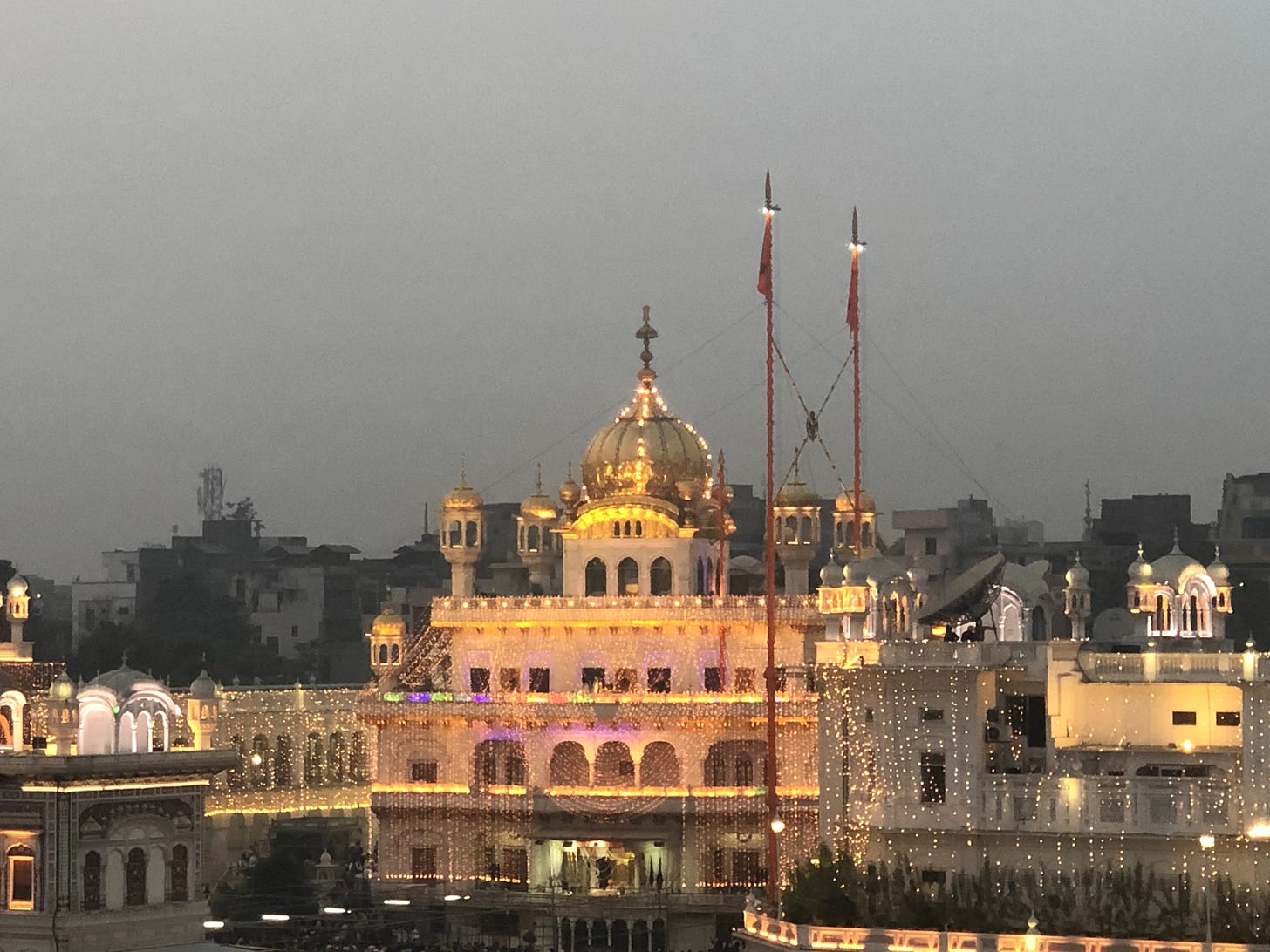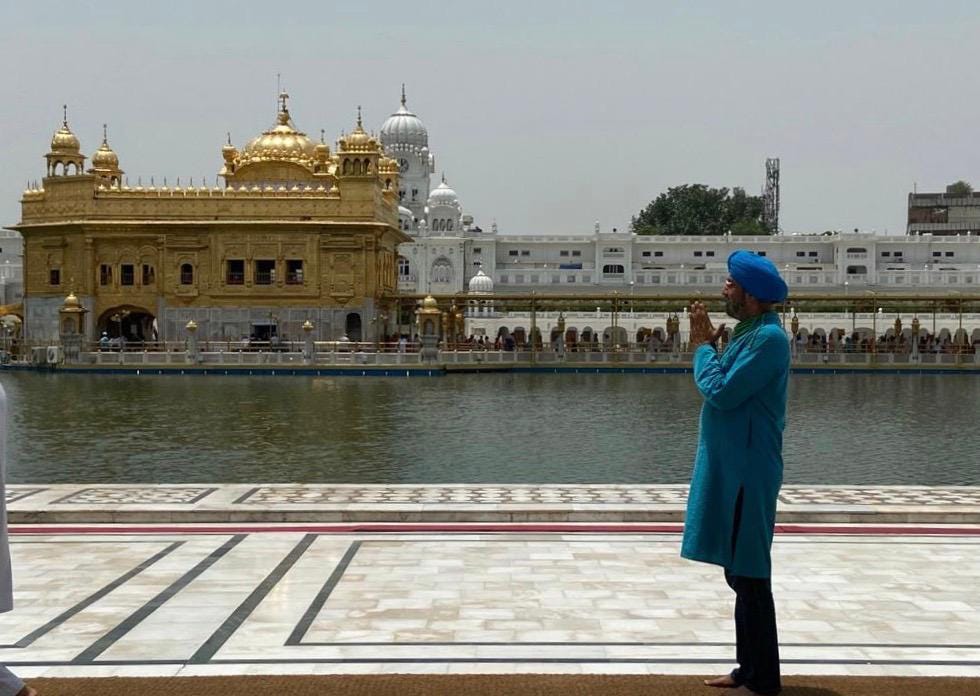Chet Sangrand (ਚੇਤ ਸੰਗਰਾਂਦ): Welcoming New Year 556 (Nanakshahi) and Spiritual Awakening in Bārah Māhā
Bārah Māhā (ਬਾਰਹ ਮਾਹਾ) & the Renewal of Life and Devotion in the month of Chet (ਚੇਤ) .
Welcoming the New Year 556 with the Nanakshahi Calendar
On the auspicious occasion of the New Year 556, according to the Nanakshahi Calendar, which dawns on 1 Chet or 14 March, 2024, we extend our heartiest felicitations to all. The Nanakshahi Calendar, a universal Sikh calendar devised by Pal Singh Purewal, a visionary retired computer engineer, was officially adopted by the SGPC in 2003. This groundbreaking calendar is anchored in the tropical solar year, diverging from the traditional lunar cycle to provide consistency in dates from year to year, marking a monumental shift in the observance of Sikh festivals and commemorations. Named in honour of Sri Guru Nanak Dev Ji, the the First Sikh Guru and the founder of Sikhism, the Nanakshahi Calendar embodies a profound stride towards reinforcing Sikh identity.
Chet: A Month of Renewal and Spiritual Significance in the Nanakshahi Calendar
Chet, recognized as the inaugural month in this solar calendar, holds a place of distinction not just for its position as the start of the year but also for its spiritual significance, as underscored by Guru Arjan Dev Ji in the Bārah Māhā Paath. By placing Chet at the forefront, Guru Arjan Dev Ji highlights the month's essence of rejuvenation and spiritual awakening, making it a beacon of new beginnings and profound contemplation for Sikhs around the world.
Bārah Māhā and the Awakening of Spiritual Renewal in Chet
The Bārah Māhā (ਬਾਰਹ ਮਾਹਾ), a seminal spiritual composition by Sri Guru Arjan Dev Ji, is an essential part of the Sri Guru Granth Sahib, encompassing Angs 133 to 136. This revered scripture, often recited during Sangrand to signify the advent of a new month, serves as a spiritual compass guiding devotees through the cyclical journey of the soul through various seasons. Each month reveals distinct spiritual lessons, reflecting the soul's fluctuating emotional and spiritual states against the backdrop of the changing seasons.
Chet: A Time for Spiritual Awakening and Renewal
With the arrival of Chet (ਚੇਤ), the month that heralds the nearing of the harvest season, Bārah Māhā presents its themes of renewal, rejuvenation, and divine engagement. In the verses dedicated to this month, Guru Arjan Dev Ji utilizes evocative and rich poetry to illustrate the soul-bride's (humanity's) pursuit of unity with the Divine. Chet is depicted as a period of awakening, where the natural revival of the earth mirrors the soul's reawakening and deepening of spiritual love and devotion.
Sri Guru Arjan Dev Ji's teachings during Chet highlight the importance of embracing spiritual renewal and the joy of reconnection with the Almighty, marking a departure from the reflective mood of the colder months and the weakening of winter in Phagun, the previous month. This month is metaphorically seen as a stage of spiritual rebirth and exuberant devotion.
For those interested in delving deeper into the essence of Chet, I welcome you to watch the Punjab-English video I shared on this subject with a Canadian TV channel some years ago.
Chet's Teachings: A Renewal of Spirit and Devotion
In the verses dedicated to Chet within Bārah Māhā, there is a profound focus on the renewal of the spirit, the awakening of inner consciousness, and the fortification of devotion. This month calls us to observe the rebirth of the natural world, appreciate the intricacies of creation, and feel the nurturing embrace of Divine love. Embodied with rich symbolism and profound insights, these teachings offer solace and enlightenment, encouraging a more intimate connection with the omnipresent Divine love.
By engaging with the teachings of Chet, as depicted in Bārah Māhā, and participating in the vibrant festivities of Hola Mohalla, which this year occurs within Chet, devotees are invited into an exceptional blend of spiritual exuberance and cultural remembrance. This solidifies the eternal Sikh values of love, courage, and unwavering devotion.
(AI-generated images, enhancing Sri Guru Arjan Dev ji’s paintings available on the internet; dictating the Adi Granth to Bhai Gurdas ji.)
Line-by-line Interpretation
Let us now embark on a spiritual voyage, absorbing the line-by-line translation and interpretation of these nine sacred verses.
1. ਚੇਤਿ ਗੋਵਿੰਦੁ ਅਰਾਧੀਐ ਹੋਵੈ ਅਨੰਦੁ ਘਣਾ ॥
Transliteration: Chet Govind araadheeai hovai anand ghanaa.
Translation: In the month of Chet, by meditating on the Lord of the Universe, a deep and profound joy arises.
2. ਸੰਤ ਜਨਾ ਮਿਲਿ ਪਾਈਐ ਰਸਨਾ ਨਾਮੁ ਭਣਾ ॥
Transliteration: Sant janaa mil paaeeai rasnaa naam bhanaa.
Translation: Meeting with the humble Saints, the Lord is found, as we chant His Name with our tongues.
3. ਜਿਨਿ ਪਾਇਆ ਪ੍ਰਭੁ ਆਪਣਾ ਆਏ ਤਿਸਹਿ ਗਣਾ ॥
Transliteration: Jini paiaa Prabhu aapnaa aaye tisehi ganaa.
Translation: Those who have found their God—blessed is their coming into this world.
4. ਇਕੁ ਖਿਨੁ ਤਿਸੁ ਬਿਨੁ ਜੀਵਣਾ ਬਿਰਥਾ ਜਨਮੁ ਜਣਾ ॥
Transliteration: Ik khin tisu bin jeevnaa birthaa janam janaa.
Translation: Living without Him, even for an instant, makes our life utterly worthless.
5. ਜਲਿ ਥਲਿ ਮਹੀਅਲਿ ਪੂਰਿਆ ਰਵਿਆ ਵਿਚਿ ਵਣਾ ॥
Transliteration: Jal thal maheial pooriaa raviaa vichi vanaa.
Translation: The Lord is fully present in the water, the land, and all space, pervading the forests too.
6. ਸੋ ਪ੍ਰਭੁ ਚਿਤਿ ਨ ਆਵਈ ਕਿਤੜਾ ਦੁਖੁ ਗਣਾ ॥
Transliteration: So Prabhu chit na aavee kitda dukh ganaa.
Translation: Those who do not keep the Lord in their consciousness—how immense is their suffering!
7. ਜਿਨੀ ਰਾਵਿਆ ਸੋ ਪ੍ਰਭੂ ਤਿੰਨਾ ਭਾਗੁ ਮਣਾ ॥
Transliteration: Jinee raaviaa so Prabhu tinnaa bhaag manaa.
Translation: Those who are imbued with the love of that Lord are truly fortunate.
8. ਹਰਿ ਦਰਸਨ ਕੰਉ ਮਨੁ ਲੋਚਦਾ ਨਾਨਕ ਪਿਆਸ ਮਨਾ ॥
Transliteration: Hari darsan kau mann lochdaa Nanak pyaas manaa.
Translation: My mind yearns for the blessed vision of the Lord's Darshan. O Nanak, my mind is deeply thirsty.
9. ਚੇਤਿ ਮਿਲਾਏ ਸੋ ਪ੍ਰਭੂ ਤਿਸ ਕੈ ਪਾਇ ਲਗਾ ॥੨॥
Transliteration: Chet milaye so Prabhu tis kai paae lagaa. ||2||
Translation: In the month of Chet, I bow at the feet of the one who unites me with God. ||2||
As we engage with the wisdom of Guru Sahib in the context of Chet, our journey through this significant month immerses us in an atmosphere of spiritual renewal and awakening. Guru Sahib's guidance during Chet encourages us to observe the maturation of the earth, marking a seamless transition from the freshness of early spring to the threshold of summer. This period, roughly spanning from mid-March to mid-April in North India, inspires our hearts to participate in heartfelt devotion and to embrace the omnipresent divine love that enriches our lives.
May the insights imparted during Chet enlighten and guide us as we continue our quest for love, devotion, and spiritual enlightenment, aligning with the natural progression that surrounds us.
Placing Chet in the Broader Context of Bārah Māhā Paath
To fully appreciate the significance of Chet within the spiritual journey of Bārah Māhā, it's essential to explore the expansive narrative shaped by Guru Arjan Dev Ji. This revered compilation not only sheds light on how worldly desires can obscure our connection with the divine but also eloquently describes the soul's awakening to its spiritual essence. Each month represents a critical phase in this voyage, with the soul, portrayed as a bride, longing for the ever-present Divine—a metaphor that elegantly highlights the continuous search for spiritual unity and progression. As we explore Chet's verses, this journey embarks on a phase of rejuvenation, marking a moment of renewal and deepened divine connection as the earth transitions from the chill of winter to the vitality of spring, symbolizing a period of spiritual revival and the chance to reignite our divine passion.
Furthermore, Chet's gentle transitions and awakening life provide a spiritual backdrop that emphasizes the omnipresence of divine grace in our existence. This time extends beyond simple changes in season, prompting us to seek divine love and joyful engagement with the Almighty at every juncture. Each moment in Chet serves as a reflection of the divine, an opportunity to absorb the Guru's teachings, and a celebration of our spiritual bond, reminding us that the pursuit of spiritual enlightenment and the joy of divine love are infinite, surpassing all temporal boundaries.
Last verses of Bārah Māhā, presenting the gist
ਜਿਨਿ ਜਿਨਿ ਨਾਮੁ ਧਿਆਇਆ ਤਿਨ ਕੇ ਕਾਜ ਸਰੇ ॥ Those who meditate on the Divine Name, their tasks are fulfilled.
ਹਰਿ ਗੁਰੁ ਪੂਰਾ ਆਰਾਧਿਆ ਦਰਗਹ ਸਚਿ ਖਰੇ ॥ Those who worship the perfect Guru and Lord, stand true in the divine court.
ਸਰਬ ਸੁਖਾ ਨਿਧਿ ਚਰਣ ਹਰਿ ਭਉਜਲੁ ਬਿਖਮੁ ਤਰੇ ॥ All comforts are in the Lord's feet; they cross the treacherous world-ocean.
ਪ੍ਰੇਮ ਭਗਤਿ ਤਿਨ ਪਾਈਆ ਬਿਖਿਆ ਨਾਹਿ ਜਰੇ ॥ They attain love and devotion, and worldly temptations don't affect them.
ਕੂੜ ਗਏ ਦੁਬਿਧਾ ਨਸੀ ਪੂਰਨ ਸਚਿ ਭਰੇ ॥ Falsehood departs, duality is dispelled, and they are filled with the complete Truth.
ਪਾਰਬ੍ਰਹਮੁ ਪ੍ਰਭੁ ਸੇਵਦੇ ਮਨ ਅੰਦਰਿ ਏਕੁ ਧਰੇ ॥ They serve the Supreme Lord and enshrine the One God within their hearts.
ਮਾਹ ਦਿਵਸ ਮੂਰਤ ਭਲੇ ਜਿਸ ਕਉ ਨਦਰਿ ਕਰੇ ॥ Every month, day, and moment is auspicious for those upon whom He casts His Glance of Grace.
ਨਾਨਕੁ ਮੰਗੈ ਦਰਸ ਦਾਨੁ ਕਿਰਪਾ ਕਰਹੁ ਹਰੇ ॥14॥1॥ Nanak begs for the gift of divine vision; O Lord, shower Your Grace.
The Timeless Spiritual Union: Celebrating Divine Love Beyond Seasons
In the concluding verses, Guru Arjan Dev Ji reiterates a core principle that is central to spiritual growth: the celebration of divine love is not confined to specific times or seasons but is a continuous, ever-present opportunity. As Guru Sahib explains, every moment is sacred—whether day or night, irrespective of the month or season—when embraced with the grace of the Divine. This teaching reaffirms the message of the Bārah Māhā: every fleeting moment holds the potential for spiritual awakening and divine communion.
Guru Ji's prayer for the gift of divine vision stands as a poignant reminder to cherish each moment, seeing every occasion as auspicious for engaging in noble endeavors and deepening our connection with the Divine. This perspective embodies a life lived in spiritual consciousness, where ordinary moments are transformed into divine encounters through the soul's alignment with the infinite.
Reflecting and Looking Forward In the vast tapestry of existence, each moment—each breath—carries the potential to shine with divine light. It is not celestial alignments that sanctify a moment, but the divine presence within our hearts, illuminated by unwavering faith and devotion.
ਵਾਹਿਗੁਰੂ ਜੀ ਕਾ ਖਾਲਸਾ,
ਵਾਹਿਗੁਰੂ ਜੀ ਕੀ ਫਤਿਹ।










I am a learner and not a critique, though. So please answer my questions jn that spirit.
Well enunciated, Mr Sidhu. But I have some basic questions:
. What’s the need of this new calendar? We are trying to reinvent a centuries old and a well established calendar of our ancestors. On what spiritual wisdom? Some computer guys gets up and declares it as a more valid thing? Beyond me
. When very name is barah Maha, how it can be the first month? No where any of the gurus mentions it.
. The names Hari, Govind and Ram are well known names of Narayan in our culture. Why emphasise on the world Lord and not what it stands for? Narayan is part of the TriMurti- Brahma-Vishnu-Mahesh.
. I do not see the very point of moving away from the very roots, ie, Hindu philosophy and try est an ‘identity’; when you can have the whole, why opt for part.
. A point to rethink, probably.